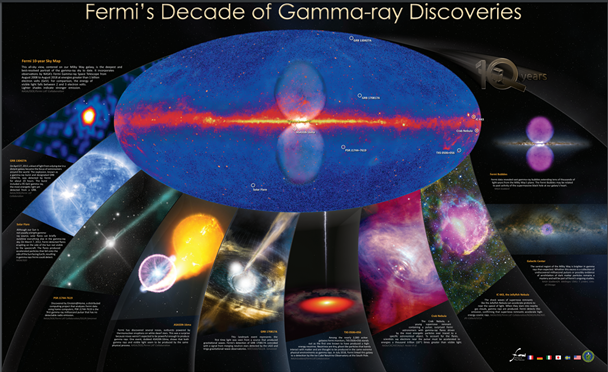

13th August 2022 (9 Topics)
Context
A study using 12 years of data from NASA's Fermi telescope helped scientists understand PeVatrons, or the source of a kind of extremely high-energy cosmic particles.
About
Findings of the study:
- Fermi has shown that the shock waves of exploded stars boost particles to speeds comparable to that of light.
- Called cosmic rays, these particles mostly take the form of protons, but can include atomic nuclei and electrons.
- Because they all carry an electric charge, their paths become scrambled as they whisk through our galaxy’s magnetic field.
- Since we can no longer tell which direction they originated from, this masks their birthplace.
- But when these particles collide with interstellar gas near the supernova remnant, they produce a tell-tale glow in gamma rays – the highest-energy light there is.
Fermi Gamma-ray Space Telescope
- The Fermi Gamma-Ray Telescope is a space observatory designed to study the universe in highly energetic frequencies known as gamma-rays.
- It includes participation from NASA, the U.S. Department of Energy, and several partners both in the United States and internationally.
- The mission was launched in 2008 and remained operational as of mid-2018.
How this telescope is opening this high-energy world to exploration?
- With Fermi, astronomers have a superior tool to study how black holes, notorious for pulling matter in, can accelerate jets of gas outward at fantastic speeds.
- Physicists are able to study subatomic particles at energies far greater than those seen in ground-based particle accelerators.
- And cosmologists are gaining valuable information about the birth and early evolution of the Universe.
In NASA's words, these are the main mission objectives for Fermi:
- Explore the most extreme environments in the universe, where nature harnesses energies far beyond anything possible on Earth.
- Search for signs of new laws of physics and what composes the mysterious dark matter.
- Explain how black holes accelerate immense jets of material to nearly light speed.
- Help crack the mysteries of the stupendously powerful explosions known as gamma-ray bursts.
- Answer long-standing questions across a broad range of topics, including solar flares, pulsars and the origin of cosmic rays.



